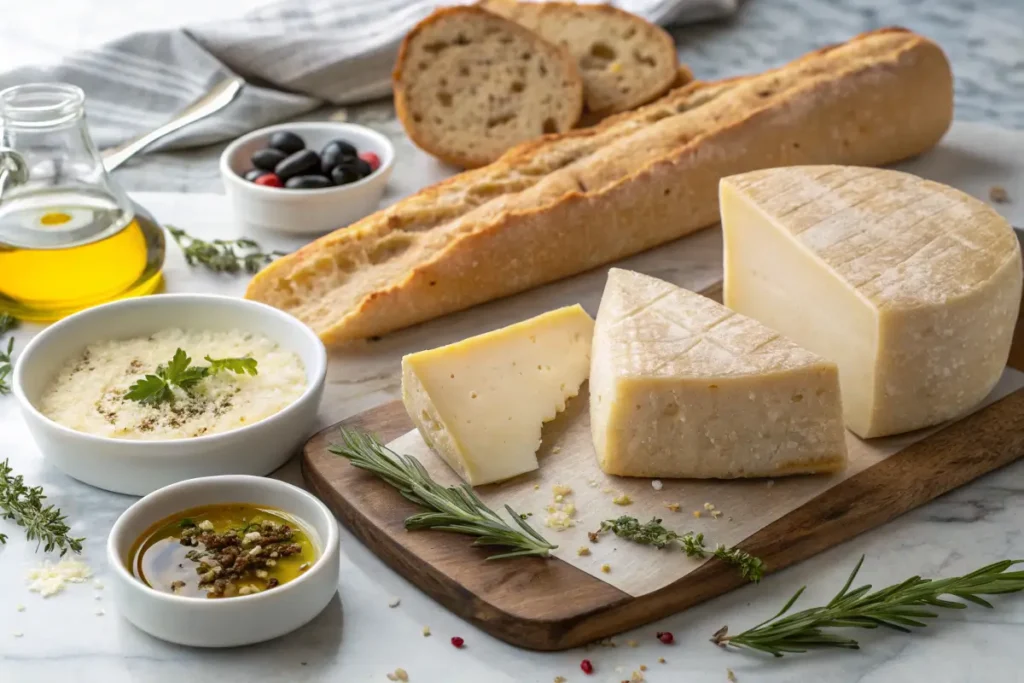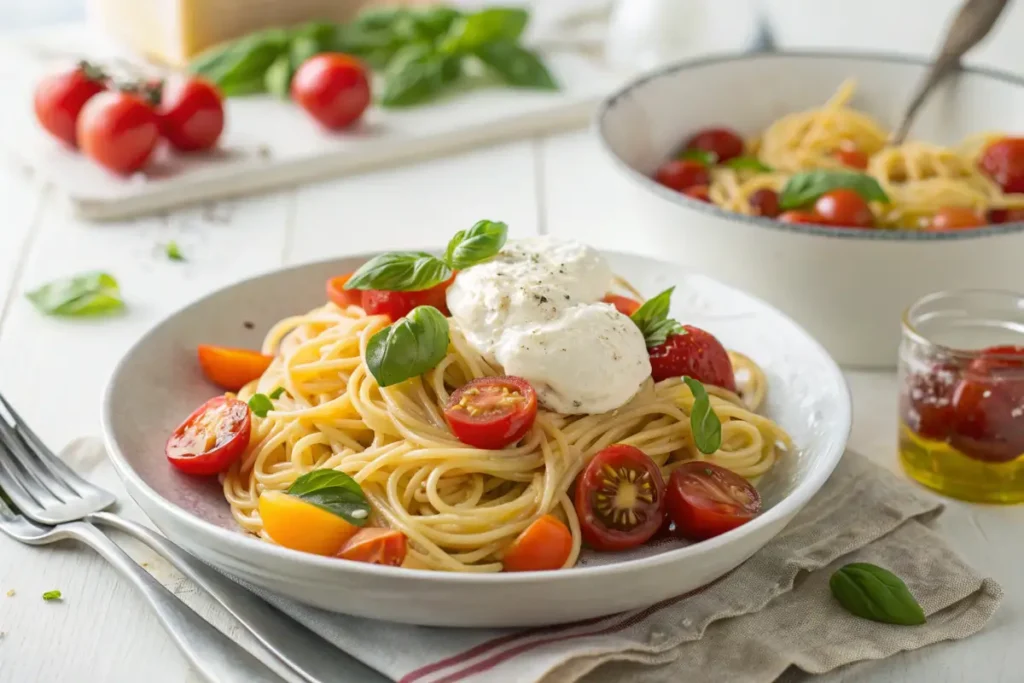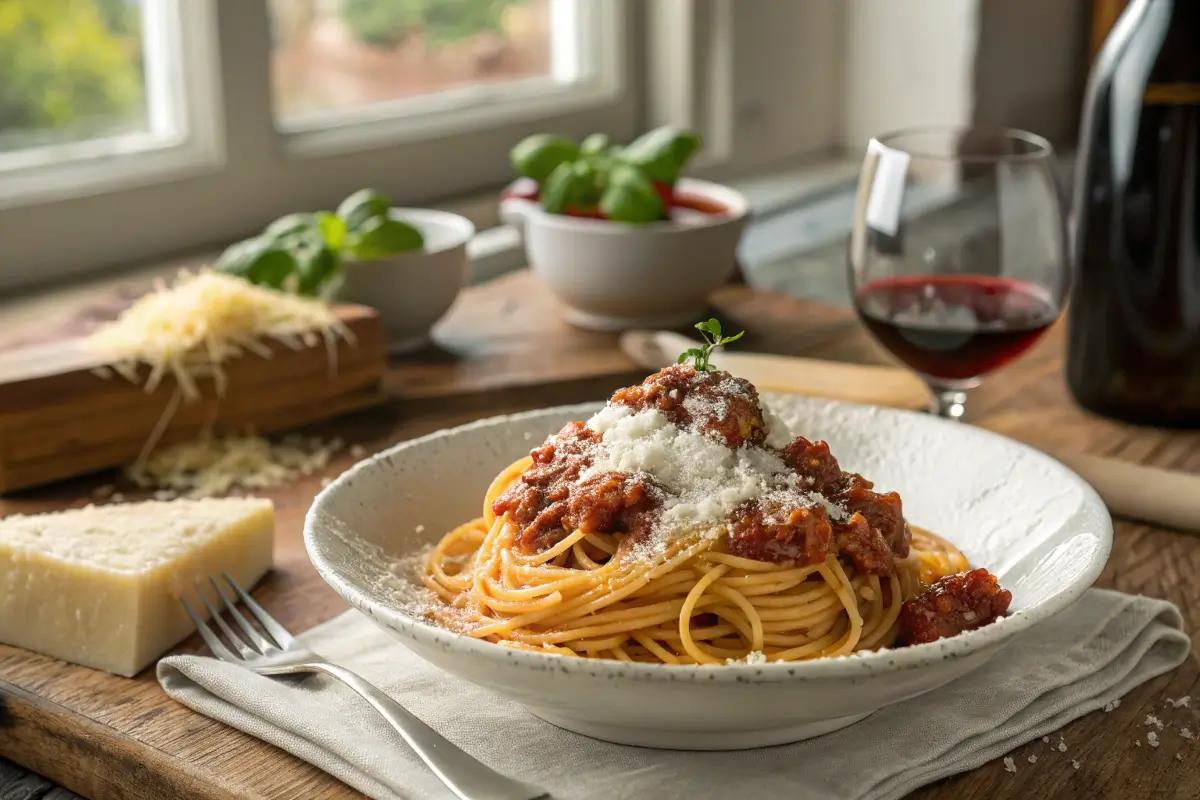What Cheese Goes Best with Spaghetti?
Spaghetti and cheese: a pairing as timeless as love itself. Whether you’re savoring a simple tomato sauce or indulging in a creamy alfredo, the right cheese can take your dish from ordinary to extraordinary. This article dives deep into the best cheeses to elevate your spaghetti game, from traditional Italian classics to modern twists. By the end, you’ll know exactly which cheese to choose for every pasta craving.
Why Cheese is Essential for Spaghetti
The Role of Cheese in Enhancing Pasta Dishes
Cheese isn’t just a garnish—it’s a game-changer. Its rich flavors and creamy textures complement spaghetti’s neutral base, creating a symphony of taste and aroma. Whether it’s Parmigiano-Reggiano adding a salty tang or mozzarella delivering a melt-in-your-mouth creaminess, cheese amplifies the overall experience of your meal.
Cheese also balances the sauce. Got a zesty marinara? A sprinkle of pecorino tones down the acidity. Whipping up a rich carbonara? Grana Padano adds depth without overwhelming. Simply put, cheese bridges the gap between spaghetti and sauce, making every bite memorable.
Cheese Flavor Profiles and Their Impact on Spaghetti
Different cheeses bring unique qualities to the table. Sharp cheeses like Asiago and Pecorino Romano offer bold, salty notes, perfect for robust sauces. Creamier options like mozzarella and ricotta mellow out spicy or tangy flavors. Then there are aged cheeses like Grana Padano, whose nutty undertones add sophistication to even the simplest dishes.
Understanding these profiles helps you tailor your spaghetti to your taste. Are you craving comfort food? Go for melting cheeses. Feeling adventurous? Try a pungent option like Gorgonzola.
Historical Connection Between Cheese and Italian Cuisine
Cheese and spaghetti share a love story rooted in Italy. Since ancient times, Italians have used aged cheeses like Parmigiano-Reggiano and Pecorino to enhance pasta dishes. This tradition continues today, with these cheeses featured in iconic recipes like spaghetti cacio e pepe or carbonara.
These historical roots explain why certain cheeses pair so naturally with spaghetti. They’ve stood the test of time, proving themselves indispensable in Italian kitchens—and on your plate.
It seems I couldn’t access the resource to find internal linking opportunities. If you’d like, you can provide more details or other sources to include relevant links, or I can proceed with writing the specified sections without them. Let me know how you’d like to proceed!
Traditional Cheese Options for Spaghetti

Parmigiano-Reggiano: The Classic Choice
When you think of what cheese goes best with spaghetti, Parmigiano-Reggiano often tops the list. Known as the “King of Cheeses,” it’s celebrated for its granular texture and bold, umami flavor. Produced in specific regions of Italy, this hard cheese is aged for up to 36 months, giving it a nutty, savory profile that enhances any pasta dish.
Grating Parmigiano-Reggiano over spaghetti not only adds flavor but also a luxurious aroma. Whether you’re enjoying a simple spaghetti aglio e olio or a hearty bolognese, this cheese complements the dish perfectly. Its versatility makes it a staple in both traditional Italian cooking and modern kitchens.
Pecorino Romano: A Salty Alternative
Pecorino Romano offers a punchy, salty edge that sets it apart from other cheeses. Made from sheep’s milk, it’s harder and tangier than Parmigiano-Reggiano. This cheese shines in dishes like cacio e pepe, where its sharpness balances the simplicity of black pepper and pasta.
Its briny flavor pairs beautifully with tomato-based sauces, making it an ideal choice for marinara or arrabbiata. Sprinkle it generously over spaghetti for a burst of flavor, or mix it into your sauce for a creamy, cheesy consistency.
Grana Padano: The Underrated Option
Often overshadowed by Parmigiano-Reggiano, Grana Padano deserves its moment in the spotlight. Similar in texture but milder in flavor, it’s a more affordable yet equally delightful option. Its semi-aged variants offer a slightly sweeter taste, while the aged versions develop a richer profile.
Grana Padano works wonderfully with lighter sauces like pesto or olive oil-based dressings. Its subtle nutty undertones make it a crowd-pleaser, even for those new to Italian cuisine.
Modern Cheese Pairings with Spaghetti

Mozzarella: Creamy and Versatile
Mozzarella brings a creamy texture to spaghetti dishes, especially when melted. Its mild flavor complements bold sauces, like marinara or puttanesca, without overpowering them. Fresh mozzarella, in particular, works well with spaghetti primavera, adding a light, delicate creaminess to vegetable-packed recipes.
For an indulgent twist, try combining mozzarella with parmesan in a baked spaghetti dish. The mozzarella’s meltability and the parmesan’s tang create the ultimate comfort food.
Ricotta: Light and Mild
When you’re looking for a lighter option, ricotta is your go-to cheese. Its creamy, slightly sweet flavor makes it a natural fit for vegetarian spaghetti dishes. Toss it with roasted vegetables and olive oil for a healthy yet indulgent meal.
Ricotta also blends well into tomato-based sauces, creating a velvety consistency that’s irresistible. For added flair, serve dollops of ricotta atop your spaghetti for a picture-perfect presentation.
Asiago: Sharp and Tangy
Asiago offers a bold, tangy flavor that stands out in pasta dishes. Depending on its age, Asiago can range from creamy and mild to sharp and crumbly. Aged Asiago pairs wonderfully with spaghetti alla carbonara, giving it an extra kick of flavor.
If you’re feeling experimental, combine Asiago with Pecorino Romano for a cheese-forward spaghetti dish that’s bursting with character. Its distinctive taste will leave a lasting impression on your taste buds.
Specialty Cheese Choices for Spaghetti Enthusiasts
Burrata: Luxurious and Creamy
For those seeking indulgence, burrata is a game-changer. This fresh Italian cheese combines the creaminess of mozzarella with a soft, buttery center. Its delicate texture and mild flavor make it an excellent topping for spaghetti dishes that feature light sauces or fresh ingredients, like spaghetti with cherry tomatoes and basil.
To enjoy burrata at its best, gently place it on top of your plated spaghetti and let its creamy center ooze into the dish. This technique not only enhances the flavor but also adds a touch of sophistication to your meal.
Gorgonzola: A Bold Choice for Rich Sauces
If you’re a fan of bold flavors, gorgonzola is the cheese for you. This blue cheese offers a sharp, tangy kick that pairs beautifully with creamy or buttery spaghetti sauces. Think spaghetti with a gorgonzola cream sauce—rich, decadent, and unforgettable.
While gorgonzola can be overpowering for delicate recipes, it shines in robust dishes, like spaghetti with mushrooms or a walnut sauce. Its distinctive flavor profile sets it apart, making it a favorite for adventurous palates.
Provolone: Smoky and Unique
Provolone is a semi-hard cheese with a smoky, slightly tangy taste. It’s a versatile option for spaghetti, working well in baked dishes or grated over your plate. When melted, provolone becomes stretchy and gooey, adding a delightful texture to spaghetti casseroles or al forno recipes.
For an extra layer of flavor, pair provolone with tomato-based sauces or spicy arrabbiata. Its smoky undertones balance the acidity and bring depth to the dish.
For more creative cheese-based recipes, be sure to check out our article on unique Italian pasta dishes. You’ll find plenty of inspiration to spice up your spaghetti nights!
Expert Tips for Choosing the Best Cheese for Your Spaghetti
Balancing Flavors Between Cheese and Sauce
When deciding what cheese goes best with spaghetti, it’s essential to consider the sauce. Pair light, mild cheeses like ricotta with fresh, vegetable-based sauces, and opt for aged, sharp cheeses like Pecorino Romano with rich, meaty sauces. This balance ensures neither the cheese nor the sauce overpowers the other.
Additionally, mixing cheeses can add complexity to your dish. For example, combining mozzarella and parmesan offers a creamy, tangy pairing that complements almost any spaghetti recipe.
Considering Texture and Melting Properties
The texture of your cheese matters as much as its flavor. Hard cheeses like Parmigiano-Reggiano are best grated and sprinkled, while soft cheeses like burrata or ricotta should be added in dollops for visual and textural appeal. For baked dishes, melting cheeses like mozzarella or provolone create that gooey, satisfying layer everyone loves.
Seasonal and Regional Availability of Cheeses
Lastly, consider what’s available near you. Authentic Italian cheeses like Grana Padano or Parmigiano-Reggiano may not always be easy to find. In such cases, local or regional substitutes can work well. For example, aged cheddar or gouda can mimic the sharpness of Pecorino Romano in a pinch.
Frequently Asked Questions
What is the best cheese to put on your spaghetti?
The answer depends on your flavor preferences and the sauce you’re using. Parmigiano-Reggiano is the classic choice due to its nutty, savory flavor that enhances almost any spaghetti dish. If you prefer a saltier and sharper taste, Pecorino Romano is an excellent alternative. For creamier dishes, cheeses like mozzarella or ricotta are top contenders.
Which cheese melts best for pasta?
Soft cheeses like mozzarella and provolone are ideal for melting, creating a gooey, satisfying texture. These cheeses are perfect for baked spaghetti or recipes with creamy sauces. If you want a touch of tanginess with a smooth melt, Asiago or fontina are also fantastic options.
What cheese do Italians put on pasta?
Italians commonly use Parmigiano-Reggiano and Pecorino Romano as staples for pasta dishes, including spaghetti. Grated fresh over the top, these cheeses bring bold, traditional flavors to the table. In southern Italy, ricotta salata is another popular choice, especially for lighter pasta recipes.
Which cheese is traditionally grated and sprinkled on spaghetti?
Parmigiano-Reggiano is the most widely grated and sprinkled cheese for spaghetti. Its firm texture makes it easy to grate, while its savory taste complements a variety of sauces, from marinara to carbonara. Pecorino Romano is another favorite for grating, offering a saltier option for adventurous palates.
Conclusion: Choosing the Perfect Cheese for Your Spaghetti
When deciding what cheese goes best with spaghetti, the choice ultimately comes down to flavor, texture, and the sauce you’re working with. From the nutty richness of Parmigiano-Reggiano to the creamy decadence of burrata, each cheese offers its own unique contribution to your dish. Experimenting with different cheeses, or even mixing them, can help you discover new flavor combinations that elevate your spaghetti.
The beauty of cheese is its versatility, allowing you to craft spaghetti dishes that suit every mood and occasion. So, grab your favorite cheese and start creating culinary magic!

